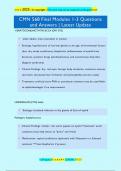2024/ 2025 | © copyright | This work may not be copied for profit gain Excel!
CMN 568 Final Modules 1-3 Questions
and Answers | Latest Update
KERATOCONJUNCTIVITIS SICCA (DRY EYE)
✓ older adults; more prevalent in women
✓ Etiology: hypofunction of lacrimal glands as we age; environmental factors
(hot, dry windy conditions), blepharitis (inflammation of eyelid from
bacteria), systemic drugs (antihistamines), and autoimmune disorders
(Sjogren syndrome)
✓ Clinical Findings: dry, red eyes, foreign body sensation, excessive mucous
secretion; decreased tear formation and photophobia (severe cases)
✓ Treatment: artificial tears PRN or petroleum ointment may be used Refer
to ophthalmologist if no improvement
HORDEOLUM (STYE) Adult
✓ Etiology: localized infection in the glands of Zeis of eyelid
Pathogens: Staphylococcus
✓ Clinical Findings: tender, red, warm papule on eyelid Treatment: warm
compress (may help lesion to "point" and drain)
✓ Medications: topical antibiotics (optional) w ith Polysporin or Sulamyd
ointment **Treat blepharitis if present
1 | P a g e | G r a d e A + | 2 0 0 2 5
,2024/ 2025 | © copyright | This work may not be copied for profit gain Excel!
ACUTE CLOSED-ANGLE GLAUCOMA
✓ Rare, optho EMERGENCY associated with elevated IOP Middle -aged or
older patients with small anterior chambers or altered iris structure;
✓ Hx of topical/oral mydriatic use or eye surgery; + family hx of glaucoma;
shallow anterior chamber (associated with farsightedness or short stature
or both); enlargement of the crystalline lens with age; inheritance (Inuits
and Asians)
PRIMARY ACUTE CLOSED-ANGLE GLAUCOMA (PACG)
✓ Acute, sudden and severe closure of the angle with very high IOP (often
5-80 mm Hg), decreased visual acuity, corneal edema, pain, nausea and
vomiting
✓ Usually occurs spontaneously in evening or dark setting
Secondary Acute closed-angle glaucoma (SACG)
✓ Etiology: underlying identifiable pathologic (neovascularization,
inflammation, developmental abnormalities, uveal effusion syndrome, or
mass lesions pushing the peripheral iris into the angle)
s/s of acute closed-angle glaucoma
1 | P a g e | G r a d e A + | 2 0 0 2 5
,2024/ 2025 | © copyright | This work may not be copied for profit gain Excel!
✓ UNILATERAL. Severe pain and rapidly progressive loss of vision (blurred
vision, halos around lights), acute photophobia; diffuse, scleral redness,
and corneal haziness
Involved Pupil: moderately dilated, unreactive to light (other pupil remains normal); elevated
IOP of affected eye - tested by digitally palpating for a hardened globe Severe Cases: frontal
headache, nausea, vomiting
Diagnosis Acute closed-angle glaucoma
✓ Slit lamp examination and gonioscopy = preferred diagnostic methods
Hallmark Findings: IOP (50-100 mm Hg), shallow anterior chamber,
corneal edema
Treatment Acute closed-angle glaucoma
✓ EMERGENT REFERRAL TO OPTHO! optic nerve atrophy and
irreversible loss of vision can occur within hours after onset
Goal: lower intraocular pressure Initial treatment is reduction of intraocular pressure
A single 500-mg intravenous dose of acetazolamide - 250 mg orally four times a day +
topical medications Osmotic diuretics (oral glycerin and intravenous urea or mannitol) - may
be necessary if there is no response to acetazolamide
Definitive tx: laser peripheral iridotomy or surgical peripheral iridectomy
1 | P a g e | G r a d e A + | 2 0 0 2 5
, 2024/ 2025 | © copyright | This work may not be copied for profit gain Excel!
Keratitis
✓ inflammation of the cornea
Risk Factors: contact lens wear (especially overnight), corneal trauma (including surgery)
Bacterial Keratitis
✓ Pathogens: pseudomonas aeruginosa, Moraxella, gram -neg bacilli,
staphylococci (including MRSA), streptococci
Causes: aggressive course; contacts (esp. overnight), corneal trauma (refractive sx)
Clinical Findings: hazy cornea and adjacent stromal abscess; hypopyon (pus in anterior
chamber)
Viral Keratitis
✓ Herpes simplex virus
Clinical Findings: lid, conjunctival, corneal ulceration (most easily visualized with fluorescein
exam); recurrences precipitated by fever, excessive exposure to sunlight, immunodeficiency
Keratitis s/s
✓ Hazy cornea, central ulcer, hypopyon (pus in anterior chamber), diffuse
erythema, usually painful eye, photophobia, grittiness o r foreign body
sensation, blurred vision
1 | P a g e | G r a d e A + | 2 0 0 2 5




